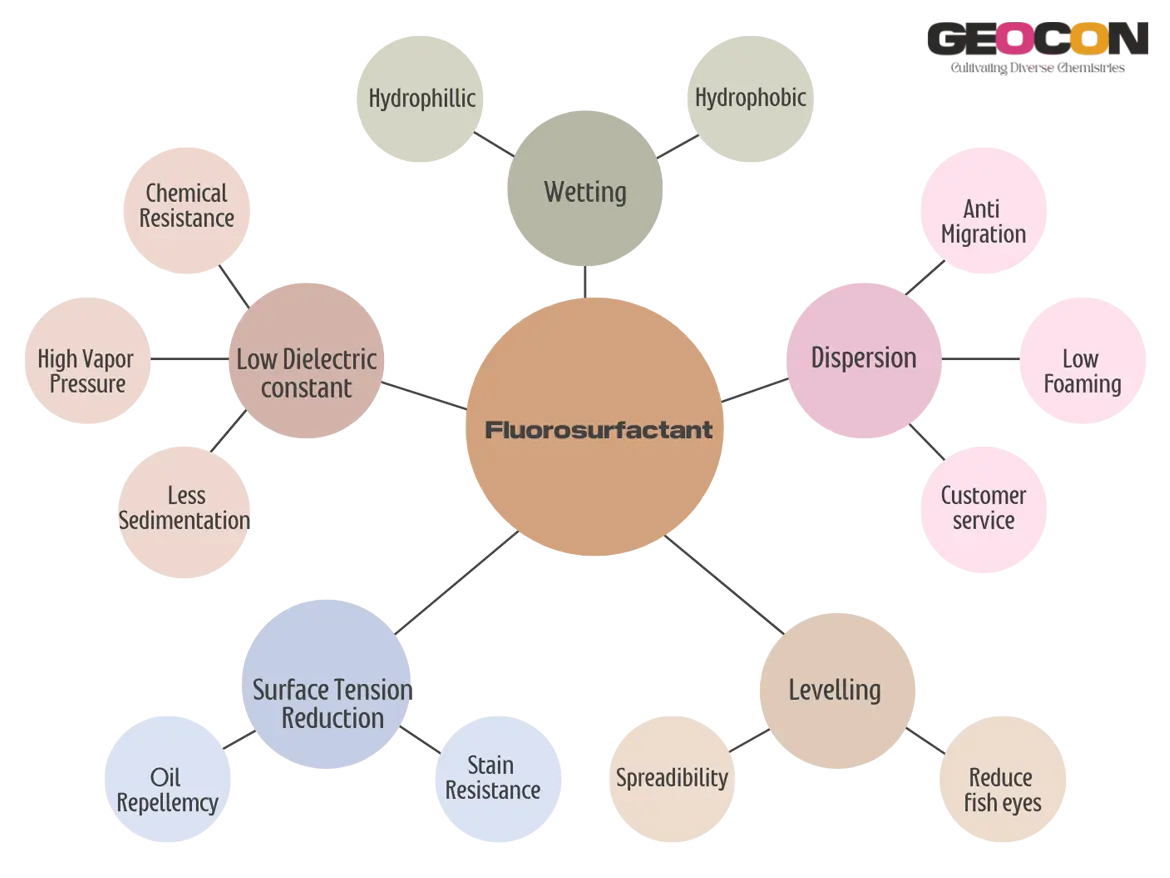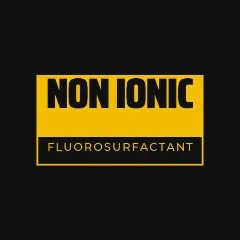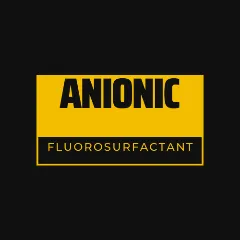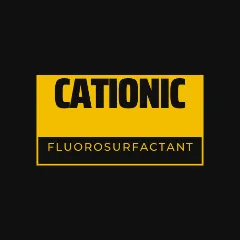Wetting of Non-Polar Surfaces: Fluorosurfactants are extremely effective in wetting non-polar surfaces, which are typically challenging for regular surfactants. This property is vital in applications like coatings and paints where uniform coverage on various surfaces is required.
Broad-Spectrum Utility : Fluorosurfactants Across Industries
In the intricate world of industrial coating additives, Fluorosurfactants stand out as a category of compounds with profound implications across a wide range of applications. These specialized surfactants, characterized by their unique fluorine-containing structures, have emerged as critical components in numerous industrial processes and products. Unlike conventional surfactants, Fluorosurfactants possess a distinctive molecular architecture, where the hydrogen atoms are replaced by fluorine atoms. This modification endows them with exceptional properties, such as extraordinary thermal and chemical stability, and remarkably low surface tensions, making them superior in performance compared to their non-fluorinated counterparts.
Products Download
Their ability to lower the surface tension of liquids significantly has made Fluorosurfactant highly sought after in industries ranging from paints and coatings to firefighting and electronics. They play a pivotal role in enhancing the properties and efficiencies of products, contributing not only to improved performance but also to the sustainability and safety of various applications. For instance, in the realm of firefighting, Fluorosurfactant are instrumental in the formulation of foams that effectively combat oil and gasoline fires, offering enhanced protection and efficacy. In the coatings industry, they are essential for achieving uniform distribution and adhesion of products, thereby extending the life and durability of paints and varnishes.
Moreover, their role extends into the realm of electronics, where they are used in cleaning and etching processes, and in the medical field, where their unique properties are utilized in pharmaceuticals and medical devices. This article aims to delve into the intricate world of fluorosurfactants, unraveling their chemical nature, diverse applications, and the significant impact they have on various industrial sectors. As we navigate through this exploration, we will uncover not only the scientific aspects of these compounds but also their indispensable role in advancing technology and improving our daily lives.
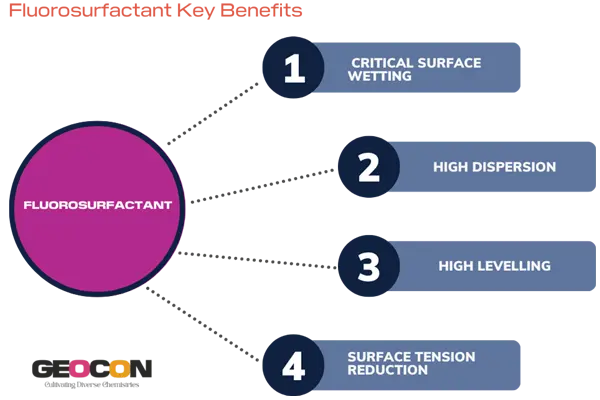
Fluorosurfactant Grades offered
(Please click on the image to get more details on the products)
Fluorosurfactants are highly effective as wetting agents in the realm of paint and coating processing. These specialized compounds are available for both solvent-based and water-borne coatings, enhancing their versatility and applicability in various industrial contexts. The primary role of Fluorosurfactant is to significantly enhance the wetting of substrates or surfaces. This property is particularly beneficial when dealing with substrates such as metals and plastics, which often present challenges in terms of achieving adequate wetting.
The superiority of Fluorosurfactant becomes evident when compared to other types of wetting agents, such as those based on hydrocarbons or silicones. Fluorosurfactants demonstrate a level of efficiency that is largely unparalleled, making them a preferred choice in many industrial applications.
To understand the mechanism of action of these compounds, consider the example of a liquid needing to spread and wet the surface of a solid. For this process to be effective, the surface tension of the liquid must be lower than that of the solid's surface. Fluorosurfactants excel in this regard by significantly reducing the surface tension of the liquid, thereby facilitating better spreading and wetting of the solid surface. This capability is critical in applications where uniform coating and adhesion are essential for the performance and durability of the final product.
Fluorosurfactants offer several key advantages that make them highly valuable in various applications, particularly in the fields of coatings, paints, and inks. Here's a breakdown of these advantages:
-
-
Wetting & Dispersion Additive for Organic, Inorganic, and Metallic Pigments: They aid in the even dispersion of pigments in a medium, ensuring consistent color and texture in the final product. This is crucial in paint formulations and other pigment-related applications.
-
Remove Flooding Effects: Flooding in paints and coatings refers to the separation of pigments, leading to color streaks. Fluorosurfactants help in preventing this issue, ensuring a uniform appearance.
-
Eliminate Cratering: Cratering is a defect in coating surfaces where small depressions or craters form. Fluorosurfactants can reduce the surface tension, thus minimizing the occurrence of such defects.
-
Less Foaming: Unlike many conventional surfactants, fluorosurfactants tend to produce less foam, which is a desirable trait in many industrial processes where foam can be a hindrance.
-
Improve Leveling & Gloss: They contribute to a smoother finish by improving the leveling properties of coatings. This results in a more aesthetically pleasing gloss and texture.
-
Stable in High and Low pH Levels: Fluorosurfactants maintain their effectiveness across a wide range of pH levels, making them versatile for use in various chemical environments.
-
Stable in High and Low Temperatures: Their stability under extreme temperatures enhances their applicability in processes that undergo significant temperature variations.

Application advantages of using Fluorosurfactants in various Industrial formulations
Fluorosurfactants are highly efficient surfactants that significantly lower the surface tension of liquids. Due to their unique properties, they find applications in a wide range of industries and products:
-
Water & Solvent borne coatings & inks: Fluorosurfactants are used to improve the wetting, leveling, and flow characteristics of coatings and inks, enhancing their performance and appearance.
-
Water & Solvent borne Sealants: In sealants, they enhance adhesion, spreadability, and durability.
-
Floor Coatings Wax: They improve the application and durability of floor waxes, providing better protection and shine.
-
Photographic Emulsion: They are used in photographic emulsions to improve the dispersion of particles and enhance image quality.
-
AFFF (firefighting foam): Fluorosurfactants are key ingredients in aqueous film-forming foams (AFFF), used for firefighting, especially in oil and fuel fires.
-
Glass Cleaner: They help in streak-free cleaning of glass by reducing surface tension and enhancing spreading.
-
PTFE Non-Stick Coatings: They assist in the application process of PTFE (Teflon) non-stick coatings on cookware and other surfaces.
-
Soldering Paste: They improve the wetting properties of soldering pastes, facilitating better solder flow and joint quality.
-
PVC Plastisol: In PVC plastisols, fluorosurfactants enhance flow properties and thermal stability.
-
PU Pigment paste: They assist in the dispersion of pigments in polyurethane systems.
-
Diamond Fillers & Coatings: Used to improve the adhesion and finish of coatings and fillers on diamond surfaces.
-
Precious Stone and Diamond Coatings: Similar to diamond fillers, they enhance the appearance and durability of coatings on precious stones and diamonds.
-
Natural Stone Coatings, Fillers, and Converters: They enhance the penetration, adhesion, and protective qualities of products used on natural stone.
-
Electronic Coatings on PCB: In the electronics industry, they're used for coatings on printed circuit boards (PCBs) to provide protection and improve electrical properties.
-
Nano Coatings: Their small size and unique properties make them suitable for advanced nano coating applications.
-
Textile Finishing: They impart water, oil, and stain repellency to textiles.
-
Industrial Floor Degreaser & cleaner: They enhance the cleaning efficiency of degreasers and cleaners for industrial floors.
-
Oil well chemicals: They are used in oil extraction and processing to enhance flow and reduce friction.
-
Mold releasing compounds: Fluorosurfactants are used in mold release agents to ensure easy and clean release of products from molds.
-
Anti-Fouling formulations: These are used in marine and other applications to prevent biological fouling on surfaces.
-
Anti-Graffiti formulations: They help in creating coatings that prevent graffiti paint from adhering to surfaces, making it easier to clean.
-
Dirt Pick up resistance coatings: Fluorosurfactants are used in coatings and treatments to enhance dirt pick-up resistance (DPUR) due to their unique surface-active properties.
-
Easy to Clean coatings: With unique surface wetting and lowering surface tension properties coatings applied can be easy to clean and maintain.
Comparison between Fluorosurfactant and Hydrocabon/Silicones
Fluorosurfactants are made with 2 main properties Hydrophilic head and highly Hydrophobic tail. Fluorocarbons have been always outstanding properties due to its Fluorine atom. The specific properties of Fluorine chain in Fluorosurfactant as compared to hydrocarbon & silicone surfactant distinguished by its performance in terms of substrate wetting, dynamic surface tension or contact angle and spreading. The properties are mentioned in the following table.
